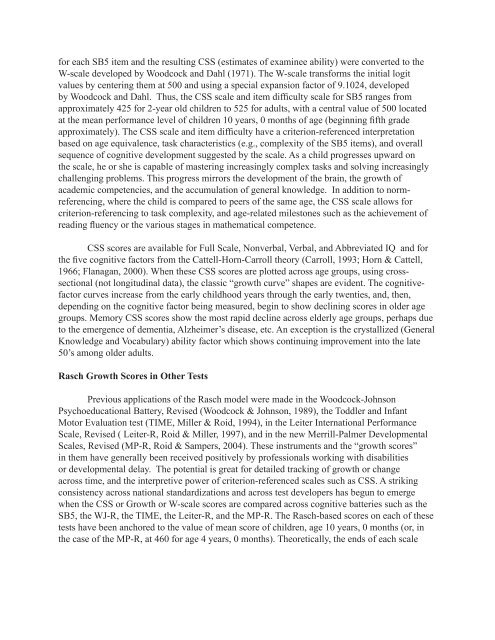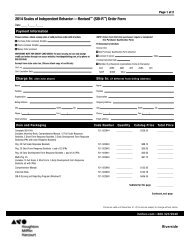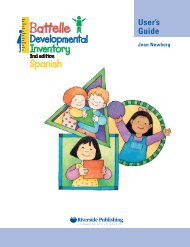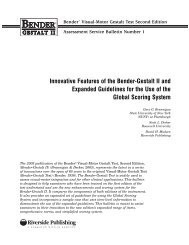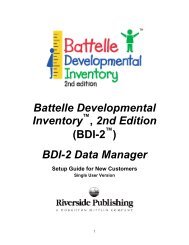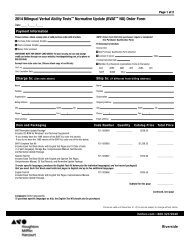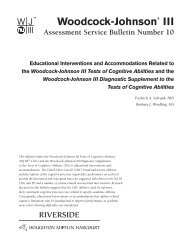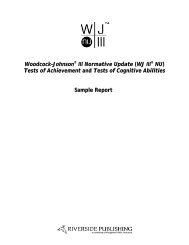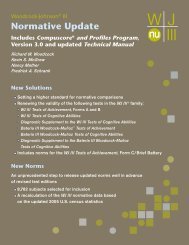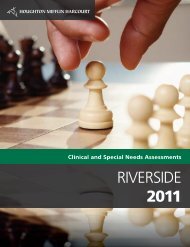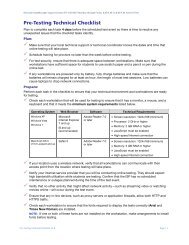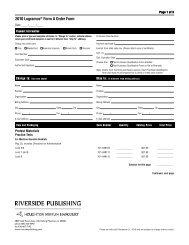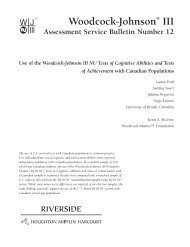Quality of Performance and Change-Sensitive ... - Nelson Education
Quality of Performance and Change-Sensitive ... - Nelson Education
Quality of Performance and Change-Sensitive ... - Nelson Education
Create successful ePaper yourself
Turn your PDF publications into a flip-book with our unique Google optimized e-Paper software.
for each SB5 item <strong>and</strong> the resulting CSS (estimates <strong>of</strong> examinee ability) were converted to theW-scale developed by Woodcock <strong>and</strong> Dahl (1971). The W-scale transforms the initial logitvalues by centering them at 500 <strong>and</strong> using a special expansion factor <strong>of</strong> 9.1024, developedby Woodcock <strong>and</strong> Dahl. Thus, the CSS scale <strong>and</strong> item difficulty scale for SB5 ranges fromapproximately 425 for 2-year old children to 525 for adults, with a central value <strong>of</strong> 500 locatedat the mean performance level <strong>of</strong> children 10 years, 0 months <strong>of</strong> age (beginning fifth gradeapproximately). The CSS scale <strong>and</strong> item difficulty have a criterion-referenced interpretationbased on age equivalence, task characteristics (e.g., complexity <strong>of</strong> the SB5 items), <strong>and</strong> overallsequence <strong>of</strong> cognitive development suggested by the scale. As a child progresses upward onthe scale, he or she is capable <strong>of</strong> mastering increasingly complex tasks <strong>and</strong> solving increasinglychallenging problems. This progress mirrors the development <strong>of</strong> the brain, the growth <strong>of</strong>academic competencies, <strong>and</strong> the accumulation <strong>of</strong> general knowledge. In addition to normreferencing,where the child is compared to peers <strong>of</strong> the same age, the CSS scale allows forcriterion-referencing to task complexity, <strong>and</strong> age-related milestones such as the achievement <strong>of</strong>reading fluency or the various stages in mathematical competence.CSS scores are available for Full Scale, Nonverbal, Verbal, <strong>and</strong> Abbreviated IQ <strong>and</strong> forthe five cognitive factors from the Cattell-Horn-Carroll theory (Carroll, 1993; Horn & Cattell,1966; Flanagan, 2000). When these CSS scores are plotted across age groups, using crosssectional(not longitudinal data), the classic “growth curve” shapes are evident. The cognitivefactorcurves increase from the early childhood years through the early twenties, <strong>and</strong>, then,depending on the cognitive factor being measured, begin to show declining scores in older agegroups. Memory CSS scores show the most rapid decline across elderly age groups, perhaps dueto the emergence <strong>of</strong> dementia, Alzheimer’s disease, etc. An exception is the crystallized (GeneralKnowledge <strong>and</strong> Vocabulary) ability factor which shows continuing improvement into the late50’s among older adults.Rasch Growth Scores in Other TestsPrevious applications <strong>of</strong> the Rasch model were made in the Woodcock-JohnsonPsychoeducational Battery, Revised (Woodcock & Johnson, 1989), the Toddler <strong>and</strong> InfantMotor Evaluation test (TIME, Miller & Roid, 1994), in the Leiter International <strong>Performance</strong>Scale, Revised ( Leiter-R, Roid & Miller, 1997), <strong>and</strong> in the new Merrill-Palmer DevelopmentalScales, Revised (MP-R, Roid & Sampers, 2004). These instruments <strong>and</strong> the “growth scores”in them have generally been received positively by pr<strong>of</strong>essionals working with disabilitiesor developmental delay. The potential is great for detailed tracking <strong>of</strong> growth or changeacross time, <strong>and</strong> the interpretive power <strong>of</strong> criterion-referenced scales such as CSS. A strikingconsistency across national st<strong>and</strong>ardizations <strong>and</strong> across test developers has begun to emergewhen the CSS or Growth or W-scale scores are compared across cognitive batteries such as theSB5, the WJ-R, the TIME, the Leiter-R, <strong>and</strong> the MP-R. The Rasch-based scores on each <strong>of</strong> thesetests have been anchored to the value <strong>of</strong> mean score <strong>of</strong> children, age 10 years, 0 months (or, inthe case <strong>of</strong> the MP-R, at 460 for age 4 years, 0 months). Theoretically, the ends <strong>of</strong> each scale


